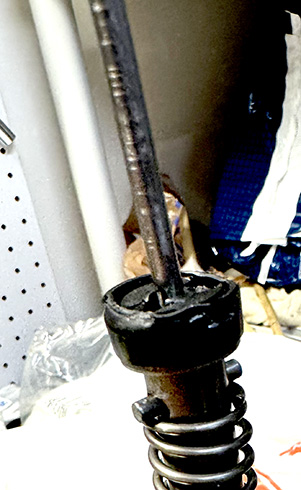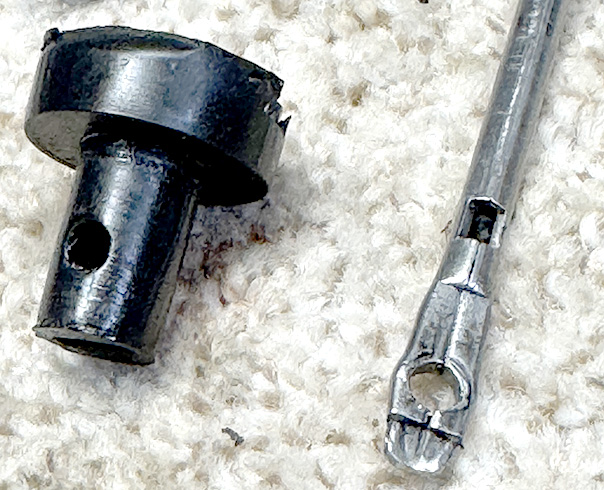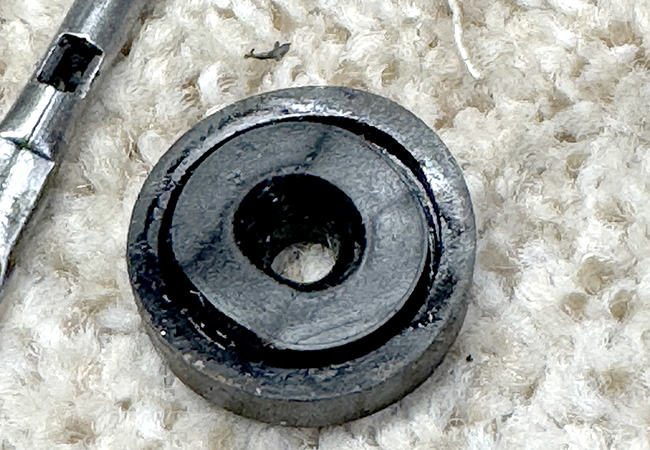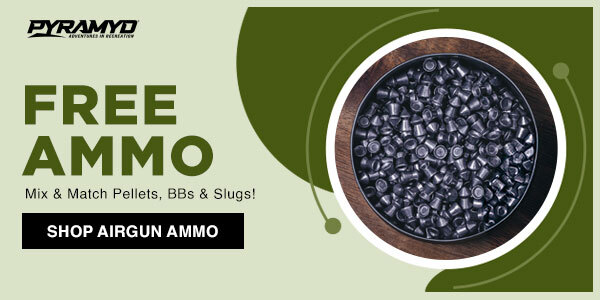
The Daisy 107 BB gun.
This report covers:
- History
- Rogers, Arkansas
- Fooled
- Blued or painted?
- Can it be repaired?
- Summary
Today we take a closer look at the Daisy 107 pump-action BB gun.
History
The model 107 we are examining is a modernized version of the Daisy model 107 Buck Jones trombone-action BB gun that Daisy made from 1934 to 1942. And that gun was a later version of the model 105 Junior Pump Gun that ran from 1932 to 1934. Sears sold that same 105 model as their model 105 Ranger.
The model 107 Buck Jones was the only Daisy that had a sundial and a compass in the stock until Daisy bowed to public opinion and made a Red Ryder patterned after the gun that featured in the film, A Christmas Story.
Author Jean Shepherd misremembered the Red Ryder and added the compass and sundial from the Buck Jones to the Red Ryder stock. Daisy made six to ten of those special left-handed Red Ryders (Ralphie was a southpaw) for the movie and then released a Christmas Story Red Ryder shortly after the movie came out. They have since made several versions of that Christmas Story Red Ryder.
The Buck Jones was a pre-war Daisy. It was made in Plymouth, Michigan. It had a wood stock and pump handle, blued steel parts and a leather piston seal.
Rogers, Arkansas
When Daisy moved to Rogers, Arkansas, in the late 1950s a lot of manufacturing changes were made. The metal parts of their guns went from being blued to painted. That process actually started in Plymouth.
The stocks, forearms and pump handles that had been wood changed to plastic (also initially in Plymouth) and Daisy underwent several years of experimentation to get the formula of the plastic right. Early Daisy plastic stocks are extremely subject to bending when exposed to heat from the sun and splitting open along glue joints.
The Rogers-built Daisy 107 (1958-1962) was no longer called a Buck Jones. The first 29,000 of them were also made in Plymouth before the move.
The stock and pump handle became plastic and the compass and sundial were gone. And what about the piston seal?
Fooled
The piston seal was what fooled BB. I saw a 107 on eBay for $50 and thought I’d take a chance, since I had never even held a 107 or a real Buck Jones. The seller said the gun worked but it had lost compression and…
Well, let me show you exactly what BB Pelletier said about that! In the report titled, Know what you have or want, I said,
“I was attracted because this was a Daisy BB gun. I know why 99.999 percent of all Daisy-type BB guns have no velocity. I’ve written about it several times in reports on Daisy No. 25 pump guns. Why do you think there is no velocity? This is a test to see if you’ve paid attention.”
I thought I could just oil the piston seal and get the gun shooting again. There is an old saying, “Man plans and God laughs.” I was His comic relief that day, because when the gun arrived I oiled it and it still shot slow!
Could the Rodgers-made 107 have a synthetic piston seal? Well, let’s see. Could some older Hollywood actresses have had cosmetic surgery?
I disassembled the BB gun which was easy. By the way, there is an excellent video on You Tube that covers 1934 Daisy Air Rifle BB Gun Repair and Restoration. It’s 20 minutes long and is extremely well done. When I grow up I wanna be just like the guy who made that video! I won’t show detailed pictures of the 107 disassembly in this report because both the old Buck Jones and the newer model 107 come apart the same way.
But the piston seals are made from different materials! Instead of a leather seal the newer Rodgers-made 107 has a two-part rubber piston seal. Ooops!

This is part of the 107’s piston seal in place on the piston rod. Notice how long the silver air tube is. That’s another peculiarity of the 107.

A detailed view of the air tube (BB gun equivalent of the transfer port) and the rear piston seal. The round holes are for the cross-pin seen in the last photo.

The front piston seal. Is it a parachute seal? BB doesn’t know.
Blued or painted?
Here is a real toughie. Is the Rogers-made 107 blued steel or painted? Daisy was painting BB guns when they were still in Plymouth. I have a Number 25 Plymouth pump gun that was made around 1956 and it is painted.
The 107 I have is finished beautifully and it does not look like paint. I haven’t found anything that tells when the serial numbers were made but I do know the very first 107s (not Buck Jones) were made in Plymouth. Their serial numbers all started with an A. My gun serial begins with the letter F, so it’s a later one. And no doubt it is painted, though it doesn’t look like it.
Can it be repaired?
I always tell folks that there are no repair parts for the older BB guns. That’s mostly true, but sometimes you can get lucky and find what you need. But piston seals are parts that wear out and there are none for the 107 that I can find.
But can they be made? Reader Ian McKee has told us about 3D printing that can make a lot of things. Can the 107 seal parts be made? We shall see because Ian and I are looking into it right now.
Summary
This is where I will stop. I will continue to attempt to repair the 107 and I’ll also let Ian have a go at making new seal parts for it. Sounds like there are several more very interesting reports coming.

Have a great weekend everybody!
-Yogi
BB,
3D printing can be wonderful. But, in replacing the two part seal on this BB gun, I’m not quite sure how easy it will be to replicate the proper durometer (flexibility/hardness), durability and resistance to oil, in an affordable material available for a 3D printer.
I do have faith in the research ability of you & Ian (also, the commenters in this blog).
Have fun.
Bill
It’s an antique BB gun.
I could be wrong, but I would think that “close enough for government work” would be sufficient in replicating the durometer of the seal.
I can control the internal structure of the part to adjust the hardness/ flexibility.
Once it’s cooled, it doesn’t tear it has to be cut.
And from experience in using TPU for seals for airsoft guns, it is stable with the oils we use in airguns.
Ian.
This will be fun.
Tom and Ian,
Possibly you can use an O-ring to create the seal after printing out a body to attach to the shaft.
Siraniko
Hmm, i have never been into a 107.
But if I am reading this right, the rubber seal in the third photo, fits into the top of the black part on the left in the middle photo?
And the metal air tube goes into both parts, then that entire assembly goes into the end of the piston rod and is retained by the cross pin.
The part that holds the seal and rod looks like metal, but I am not sure.
The rubber seal I can replicate, the part the seal and rod goes into, also yes, but if it’s made from plastic, the plastic printing material I have the ability to print with may have a limited , life slamming to a stop under heavy spring pressure.
Unless I make it from the same material as the seal. (TPU) I can control the internal fill and structure of the parts to make one part harder like plastic, and the inner seal softer so it can expand with the air pressure as it is driven forward.
Ian.
Also, I do know a talented machinist that is also an Airgunner here locally that can machine that part from Delrin or Peek if needed.
Ian,
You are reading it right. Both parts are soft like rubber and they assemble one on top of the other.
BB
This looks similar to the setup on my Daisy1894 lever action Winchester replica.
The front seal is for the air transfer tube to pass through, back and forth, as the piston it’s pinned to moves. I believe it remains inside the compression tube at the opening end. Mine was stuck there when I took it apart.
The tube always remains in this seal, even when the piston is compressed the tube sticks out from the front of the compression cylinder. It pushes a stacked BB into the barrel when the piston is released forward while transferring the air into the barrel.
The front seal prevents compressed air from going around the air transfer tube instead of through the square cutout just in front of the rear ‘Piston’ seal and out the other end of the tube into the barrel.
It is more of a compression cylinder seal for the air transfer tube than a piston seal but both work together to contain compressed air and direct it into the square cutout on the tube. The rear seal on the piston head is a standard cup shaped seal, if I remember.
The piston seal may slam into the transfer tube seal or ride along with the tube seal and bottom out together? All I know is the air tube front seal remained stuck in the cylinder when I removed the piston / air tube assembly.
Just a side note. I found three different inside diameters in the air transfer tube. The older air rifle had the biggest. I can only assume the newer ones were restricted to reduce the power. The last ‘Winchester’ copy if the Daisy 1894 was so restricted air was still hissing out of the barrel long after the BB left it. It basically gave the piston an air cushion stop. Guess it was easier than changing out the main spring to cut back the power?
BB-
Sorry, I have no help to offer with your model 107.
I do have a couple of the special Red Ryders from the release time frame of ‘A Christmas Story’.
The first one was made in August ‘83 and was to be a Christmas merchandise tie-in with the movie (released mid-November).
The second one was made in May of ‘84. The overwhelming and surprising response to the movie dictated a summer rerelease with additional tie-in merchandise.
The first gun would have been attached to a cardboard backer and then shrink wrapped. Few of this type packaging survived.
The second gun had a proper cardboard box with higher survival rates.
Daisy had to scramble a bit with the initial series guns. They had difficulty sourcing enough small compasses of one type. Therefore there are several variants depending on which compass is installed in the stock.
For some reason, ever since this 107 was mentioned, I’m starting to see them pop up on online auctions–perhaps I am just noticing them now. Similarly, there are several double-barrelled Daisy BB guns floating around on the auction websites these days….
RG,
Of course they do. I have noticed such at airgun shows also. I have learned a long time ago that if you want a good deal on an airgun, you have to get ahead of BB. Once he mentions it, they come out of the woodwork and the price skyrockets.
As with Paco, I am of not much help. Despite my “advanced” experience, I have never been inside a Daisy. I do need to go inside my 99 though. The aluminum trigger is very light; therefore I am certain it needs to be replaced. My only hope is that such can be had.
I may have to take the trigger and the shot tube with me to the next airgun show. It would also be nice to find a few extra tubes to hopefully have it shoot even better.
I do wish I had one of those Alfie Red Ryders.
Let us address the question of can an old bb or other old airgun be repaired.
The answer is sometimes. I have been to several airgun shows over the years and have seen some dealers who have geegobs of used parts with which to repair some of these older airguns. If and when you go to one of these shows, bring the part you would like replaced with you. You just might get lucky.
A couple of years ago I was at the NC show and there was a dealer there who had a big display case of old/brand new parts for Webley air pistols. This was an original, Webley display, telling where each part was used in which Webley. These parts were still in their original boxes. Because of him I was able to fix my old Webley Junior. Despite everything being stacked against you, you sometimes win.
BB
Does the design preclude making leather replacement seals?
Deck
Deck,
I don’t know but that is a good idea.
BB
The video you posted the link to is amazing. The guy has a lot of talent and appears to know a lot about how to go about restoring things. If you watch the video it becomes apparent that where there is a will, there is a way. Ingenuity always fascinates me, I will likely want to watch that video again! The end result is a beautifully restored gun, but it took a lot of tedious work.
Looking forward to seeing how this seal replacement turns out. Thankfully the rest of the gun already looks a lot better than the one in the beginning of the video did! 😉
BB
It might just be me but that Daisy Model 107 Trombone BB gun may be the most beautiful one I’ve seen. Daisy currently offers a Model 12 which is available on their website for about 49.00 USD. Please find below , a copy of the parts diagram from J&G. Hope this helps. In addition, they are offering the piston seal for about 20.00.
In my mind, this would be the ultimate shooting gallery gun and be perfect to shoot against the neo 30 at 10 feet.
Kind Regards
jda001
Piston Seal
Piston Seal
jda001,
Here is what I get when I search:
BB
Copy of link I used this morning
https://www.jgairguns.biz/107-c-78_186_191/
It appears that they call it a plunger head. Sadly the note at the bottom seems to indicate it won’t fit your gun.
Elmer,
No, my gun is the only Daisy that plunger head will fit.
I ordered one.
BB
Great! I guess I got confused from reading the history of these guns and thought your gun was made in Plymouth, MI.
BB,
Congrats on getting a sweet vintage Daisy BB gun! Regarding your need for a new piston, there is an eBay seller whose address is accurateairguns.com. I bought a repair kit for a Daisy 25 that includes a piston. The diameter is 13/16″ at the top of the taper and 3/4″ at the bottom. Would this fit your compression tube?
BB,
I began to add BB guns to my amassment of air guns and I do enjoy shooting them. The plastic butt stocks of the two #25s have deformed a bit. Since I’m such a goof ball, I sketched up a second butt stock and look, it has a palm swell! You introduced us to the concept saying you like them, so I wanted to try it out. It’s pretty swell! The swell is longer than it is wide and fills the space between the knuckle calluses and the meat of the thumb and seems to lock your hand into position. But the whole thing needs to be better, so another has to be made before I commit to cutting the beautiful piece of black walnut that is intended for one of these 25s.
Will, you are on a whole other level! So cool!
Thank you RG!
B.B.
That gun is gorgeous! I so hope you get it working. Just wondering, about what FPS would this guns normally shoot in the day? I’m guessing around 300 fps? Looking forward to seeing this one going again.
Doc
Doc,
I’m guessing the velocity will be just under 300 f.p.s., like 275 or so. But I really don’t know and it seems that most of the 107s like this one have the same problem. Sellers know they can cock and fire the gun and they don’t bother trying it with a BB, other than the super-honest guy who sold the one you are seeing.
BB
Additional thought about that air transfer tube seal.
It would need to remain at the front of the compression cylinder to allow air to compress in the cylinder. If it sat in front of the piston seal on the air transfer tube it would be acting as a piston seal and there would be no compression with a hole out front as big as the transfer tube.
It would also block off the square notched cutout hole in the tube for compressed air to enter.
So yes, it needs to stay out front in the compression cylinder. Compressed air may spread it out to seal off the tube better. The parachute effect?
And some of you may be asking why an air transfer tube is even there. I know I did at first.
Then it became obvious. A break barrel springer doesn’t have one, yes, but it is a single shot rifle. The ones without a mag anyway.
Air rifles like this have many BBs stacked up under spring pressure, or gravity somewhat, to be fed into the barrel. Without the air transfer tube BBs could simply fly out of the barrel as air blows through it, being pushed into the air stream.
The transfer tube does two jobs:
1. Being just a bit smaller than the barrel bore it only pushed one BB into the barrel then blocks off the BB feed hole, so the rest stay put.
2. It prevents pressurized air from going into the BB feed hole and causing who know what havoc.
Not sure if there is anything to be gained by porting out the air entrance opening of the tube, in fact it may weaken it, but, you can sure increase the FPS by opening up the tubes bore some, Not too much there either. The piston will be slamming home a bit faster with less air resistance and probably shortening its useful life and of course voiding your warrantee.
But if your the Tinkerer who says “I don need no stinken warrantee” have at it. Will need an extra-long drill bit. One way in.
BB that piston seal may only come as an entire piston head assembly?
Team
If anyone is looking for the modern equivalent of the 107, take a look at the Daisy Model 12. Daisy may be discontinuing the model. I feel sorry for the low end of the market, not sure if Gamo will support in any meaningful way. The Model 12 is a smoothbore, trombone BB gun and fun at 15 feet or less. The Model 12 has a wood stock and pump but a plastic receiver. Not sure how long it will last but fun until it’s not. Not everything needs to last forever and priced accordingly.
Kind Regards
jda001
B.B.,
I was looking for a (https://geissele.com/17-7-62mm-suppressor-alignment-gage.html) on the Geissele Automatics Company Website and looked around a bit and stumbled back to this item: https://geissele.com/hi-speed-national-match-trigger-set.html. My rememberer told me you had wanted to look into getting one (National Match) to drop into your AR-15.
Did you ever pull the trigger on their NM trigger group? They are all that folks who are “SLOW” shooters keep saying are the best. I have used Velocity, Timney, and others in both single and two stage and keep returning to the Geissele NM trigger group as the one i like best. The adjustability method/process of the Geissele is also one that i believe is more robust than any other National Match trigger. Changing out the springs first to change the basic feel and function makes so much more sense to me.
I wonder if Geissele had something to do with the SIG ASP20 trigger group; the two companies appear to have a B2B relationship.
If you haven’t i’m enabling you to take a step you will not regret.
shootski
Daisy has the Winchester Model 12 listed as, “Out of stock”. Gamo, has it listed as “Discontinued”. P/A, ‘0’ listed. I may have gotten one of the last?
Wonder if the piston head, or seal, will fit one of my worn-out Daisy 1894 lever actions?
May find some New Old Stock someplace, but I doubt it.
Bob M
Good morning
Not sure if you were looking for a 1894 piston seal or new old stock for the Model 12. I have attached the link to the JG site for the 1894 seal.
https://www.jgairguns.biz/1894-c-78_186_206/dai1894phs-synthetic-piston-seal-p-11432.html
Hope it helps
jda001